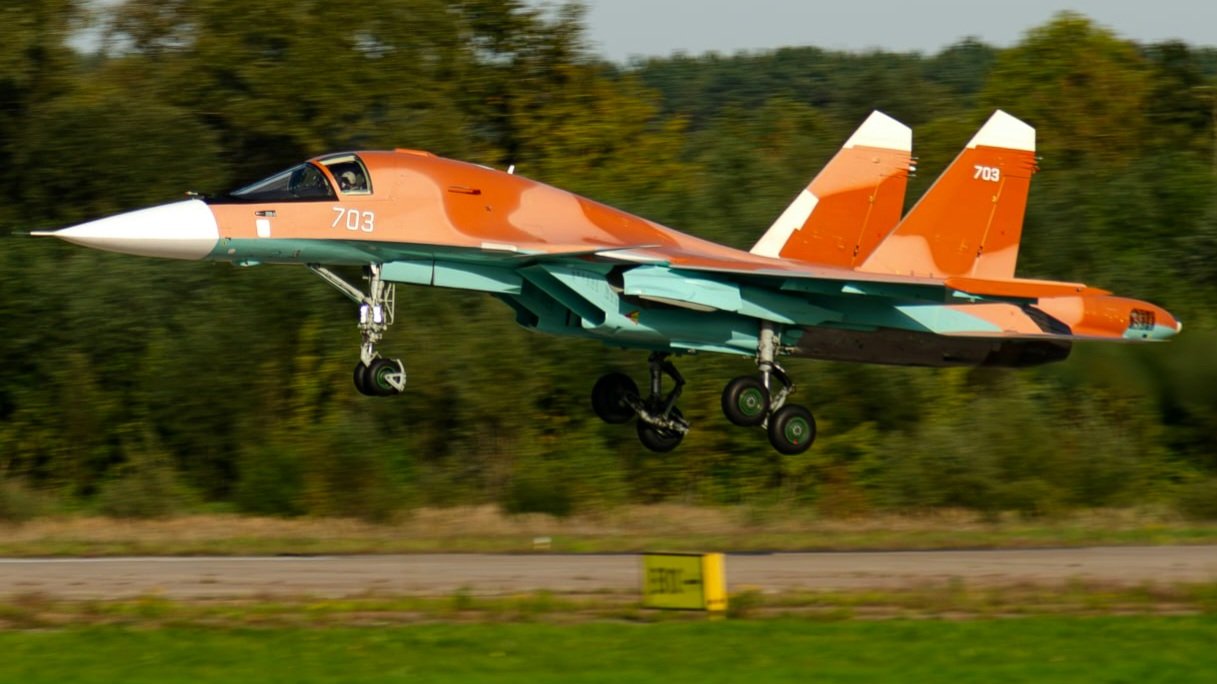1st Buyer Of Russia’s Su-34 Revealed In Hacked Documents; Claims The Country Is Also Acquiring Su-57 Jets

Russia’s Sukhoi Su-34 ‘Fullback’ fighter bomber could have its first export customer more than a decade after it was formally introduced into service.
The aircraft, which has been the backbone of the Russian onslaught on Ukraine, could bolster the capability of the Algerian Air Force alongside the Su-57 Felon, if leaked documents from Rostec, hacked by ‘Black Mirror’, are to be believed.
Among a host of other crucial details, the document purportedly listed the precise costs, delivery dates, and export strategies for multiple Sukhoi fighter jets headed to international customers, including Algeria, Iran, and Ethiopia.
The leaked document claims that Algeria has purchased 12 Su-57 fifth-generation fighters and 14 Su-34 (likely the Su-34ME variant) fighter-bombers. It also claims that Iran has ordered 48, while Ethiopia has ordered six Su-35 fighter jets.
If the claims are true, Algeria would become the first foreign buyer of the Russian Su-34 Fullback fighter-bomber as well as of the Su-57 fifth-generation stealth aircraft. It would also confirm previous reports in Algerian state media that first reported the purchase and claimed that Algerian pilots were training on the jets in Russia.
Algeria’s Quest For Su-34
The Su-34ME (an export model of the Su-34M), intended for Algeria, features several enhancements designed to meet export requirements, incorporate environmental adaptations, and incorporate advanced survivability features.
While the core airframe, engines, and strike capabilities remain consistent, experts believe that the key modifications may focus on electronic warfare (EW), countermeasures, and integration with modern munitions. The latest L-265VE “Khibiny-U” electronic warfare systems have also been reportedly ordered for each bomber.
Notably, Algeria’s pursuit of the Russian Sukhoi Su-34 fighter-bomber has been one of the longest-running arms negotiations in modern defense history, spanning over a decade.
The initial talks for the acquisition of approximately two dozen Su-34 fighters began in 2008 and continued until 2015.
In 2016, Novosibirsk Aircraft Production Association Director General Sergei Smirnov announced that the Algerian Air Force had ordered 12 Su-34s to replace its aged fleet of Soviet-era MiG-25s, after nearly eight years of continuous negotiations.
The reports from the time suggested that the purchase was likely (but not surely) a component of the $7.5 billion Algerian-Russian arms deal signed in March 2006 for the supply of anti-missile systems, aviation, sea, and land defense equipment and technologies.
In 2019, some local media outlets reported that Algeria had signed contracts for the Sukhoi Su-34, Su-35S, and Su-57, with deliveries anticipated by 2025.

However, doubts persisted over the order, and some observers predicted that an actual purchase would never materialize.
Reports in Russian media stated in March 2021 that the first batch of Sukhoi Su-34ME strike fighters, intended for Algeria, entered production at Novosibirsk Aircraft Production Association Plant. However, later that year, Russian officials denied reports that a batch of Sukhoi Su-34 fighter jets was about to be delivered to Algeria.
Cut to 2025, an export-configured Su-34M fighter-bomber, painted in a distinctive camouflage pattern, was spotted at Zhukovsky Airport near Moscow. This triggered speculations that the jets were likely undergoing flight tests before their transfer to Algeria.
However, the deliveries have not been notified as of yet, and reports suggest that they have been delayed due to domestic demands in the wake of the Ukraine war.
The delivery of the Su-34 will enable Algeria to replace its aging Su-24 fleet, bolster its combat capability, significantly alter the regional balance of power, and enhance its influence.
In addition to these aircraft, the Algerian Air Force also operates the Su-30MKA, Su-24 Fencer, MiG-29, Yak-130, and a range of Russian-origin military helicopters—making it one of the largest operators of Russian combat aircraft in North Africa.
It is also believed to have acquired the Su-35S, as seen at the Algerian Ain Beida/Oum el Bouaghi Air Base in satellite images obtained by the International Institute for Strategic Studies (IISS), a UK-based think tank, earlier this year.
The Su-34 Is Like No Other
The Sukhoi Su-34, NATO reporting name “Fullback,” is a Russian twin-engine, twin-seat, all-weather supersonic fighter-bomber designed for precision strikes, interdiction, and close air support, blending fighter agility with bomber payload capacity.
Derived from the Su-27 Flanker family, it combines fighter agility with bomber payload capacity, making it a versatile tactical aircraft. Its unique combination of features, such as the armored cockpit, side-by-side seating, long-range strike capability, and advanced avionics, makes it a specialized platform.
The cockpit is often described as an armored titanium “bathtub” with ejection seats, allowing operations up to 10 kilometres altitude without pressure suits. The aircraft is powered by two Saturn AL-31FM1 turbofans.
The Su-34 fighter-bomber incorporates canards for improved lift and maneuverability, a three-surface aerodynamic layout, and a reduced radar cross-section. The aircraft’s design emphasizes low-altitude penetration, all-weather capability, and noise reduction, according to the manufacturer.
It can carry up to 12,000 kilograms of ordnance on 12 hardpoints, including a vast array of missiles, including anti-ship, air-to-air, air-to-surface, and anti-radiation. Additionally, the Su-34 can sport both guided and unguided bombs.
The Su-34 has also been upgraded to launch a long-range cruise missile capable of carrying a conventional or nuclear warhead.
Writing for EurAsian Times earlier, IAF veteran Vijainder Thakur noted, “In a conflict with NATO, the SU-34 could carry two Kh-101 missiles, cruise undetected to its launch points, and launch the missiles from an unexpected direction. The ability of the Su-34 to launch the Kinzhal missile adds another strategic dimension, making the frontline bomber a credible deterrent.”
The aircraft has been extensively deployed on the frontline in the Ukraine conflict, particularly to launch powerful glide bombs on Ukrainian formations.
In fact, Ukrainian analysis group Frontelligence Insight earlier explained: “It takes only minutes for a [Sukhoi] jet to reach the launch area near the border and then return to the base…The large number of jets stationed at the airfield enables the simultaneous deployment of bombs, allowing multiple targets in Ukrainian territory to be engaged at once.”

It is worth underlining that the Su-34 has seen staggering losses in the conflict, with multiple fighters shot down in quick succession in late 2023-early 2024, casting a doubt over the performance of the aircraft. Many of these kills were attributed to the US-origin Patriot missile defense system deployed by the Ukrainian troops.
However, after suffering losses, the Su-34 pilots improvised.
The Su-34 pilots adopted a hi-lo-hi profile for bomb delivery to counter the increased range of Ukrainian Patriot interceptors. This method involves approaching the bomb release zone at low altitudes and high speeds, executing a steep climb, and then releasing the bombs at pre-calculated parameters to maximize range while minimizing exposure to adversary Area Denial (AD) systems.
Notwithstanding the losses, the aircraft has proved itself as the ‘highest hitting’ fighter in Moscow’s arsenal, as noted by Vijainder K. Thakur earlier.
“Going purely by the operational record, the Su-34 is currently the hardest-hitting and most cost-effective strike fighter in the world,” Thakur stated. “Its success in Ukraine, as a glide bomb delivery platform (battlefield support) with Kinzhal launch capability (interdiction), has spurred production and further development in Russia,” he added. Su-34 has already tested the Kinzhal air-launched hypersonic missile.
In August 2025, Russian sources suggested that the Su-34 was operating in tandem with the Su-35S to prevent Ukraine from effectively utilizing Western fighter jets and their powerful weapons in combat. In these ops, the Su-34 launches munitions, and the Su-35S serves as the escort and air superiority component. Thus, underscoring the combat utility of the fighters despite the losses.
While the Russian Aerospace Forces lost a host of Su-34 in combat, the production of the aircraft appears to be robust. The United Aircraft Corporation (UAC) delivered a new batch of Su-34 fighter-bombers to the VKS, as announced by the service on October 6.
“Our employees at the factories are constantly improving production processes to ensure the necessary production volumes of aircraft for the tasks of the Russian Ministry of Defense,” Vadim Badekha, General Director of the UAC, said.
The export of Sukhoi Su-34 fighter-bombers to Algeria would represent a landmark achievement for Russia, marking the first international sale of this ‘hard-hitting’ aircraft.
- Questions and Answers
- Opinion
- Motivational and Inspiring Story
- Technology
- Live and Let live
- Focus
- Geopolitics
- Military-Arms/Equipment
- Ασφάλεια
- Economy/Economic
- Beasts of Nations
- Machine Tools-The “Mother Industry”
- Art
- Causes
- Crafts
- Dance
- Drinks
- Film/Movie
- Fitness
- Food
- Παιχνίδια
- Gardening
- Health
- Κεντρική Σελίδα
- Literature
- Music
- Networking
- άλλο
- Party
- Religion
- Shopping
- Sports
- Theater
- Health and Wellness
- News
- Culture

